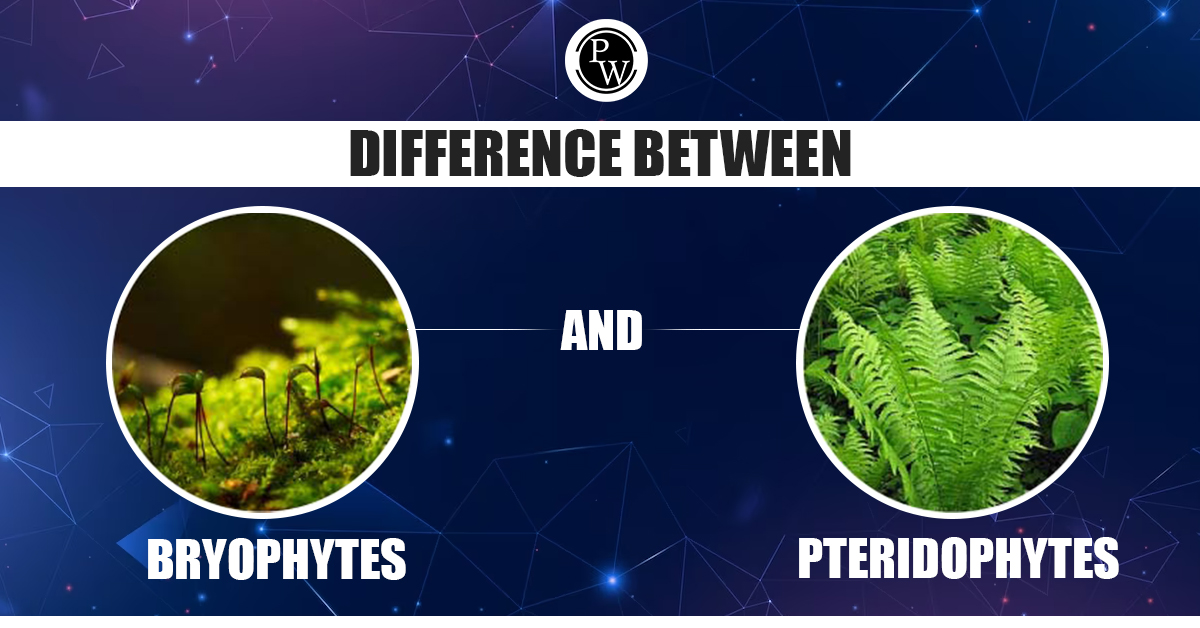

Difference Between Bryophytes and Pteridophytes: The plant structure is organized into four segments: roots, stems, leaves, and flowers, leading to the classification of plants into flowering and non-flowering categories.
Non-flowering plants, incapable of producing flowers, further fall into the classifications of bryophytes and pteridophytes. Bryophytes, thriving in moist terrestrial conditions, lack true roots and utilize rhizoids as anchors. Mosses are examples of bryophytes. On the other hand, pteridophytes, growing in wet, dark environments, consist of leaves, proper roots, and underground stems. Ferns are illustrative of pteridophytes. Blooming plants are divided into Angiosperms and Gymnosperms, sharing common features like stems, leaves, roots, vascular tissues, and reproductive structures. Bryophytes, including liverworts, hornworts, and mosses, lack xylem and phloem tissues, making them non-vascular plants. In contrast, pteridophytes such as spikemosses, clubmosses, ferns, and quillworts possess xylem and phloem tissues.| NEET Biology Syllabus | NEET Biology Diagrams |
| NEET Biology MCQ | NEET Biology Chapter wise Weightage |
| NEET Biology Notes | NEET Previous Year Question papers |
Difference Between Bryophytes and Pteridophytes Overview
Bryophytes, the most basic plants, thrive in moist terrestrial environments. They lack true roots but have rhizoids for anchorage. Mosses serve as an example of bryophytes. Pteridophytes, on the other hand, are plants that grow in damp and shady locations. They consist of leaves, proper roots, and underground stems. The leaves are finely divided into smaller parts, and ferns are illustrative of pteridophytes. Flowering plants encompass two types: Gymnosperms and Angiosperms. These plants share common features such as stems, leaves, roots, adequate vascular tissues for transportation, and the presence of flowers and fruits. Bryophytes include liverworts, hornworts, and mosses. These plants lack xylem and phloem tissues, earning them the designation of non-vascular plants. Pteridophytes encompass spikemosses, clubmosses, ferns, and quillworts, and they possess xylem and phloem tissues, classifying them as vascular plants.
Difference Between Bryophytes and Pteridophytes Table
Bryophytes, lacking vascular tissues like xylem and phloem, are non-vascular plants capable of both sexual and vegetative reproduction. Examples include liverworts and hornworts. In contrast, pteridophytes are vascular plants possessing xylem and phloem. The dominant phase in pteridophytes is the sporophyte, and ferns, spikemosses, and quillworts are among the various types of pteridophytes. Let's delve into some key differences between bryophytes and pteridophytes.
|
Difference Between Bryophytes and Pteridophytes |
||
|---|---|---|
| Feature | Bryophytes | Pteridophytes |
| Definition | Plants with a leafy or thalloid body | Roots, stems, and leaves make up pteridophytes |
| Vascular Tissue | No vascular tissue present | Vascular tissue present |
| Vasculature System | Lack a vascular system | Good vasculature with xylem and phloem |
| Roots | Lack true roots; have rhizoids | Possess proper roots |
| Stems or Leaves | No actual stems or leaves | True stems and leaves are present |
| Antheridium | Stalked antheridium | Sessile antheridium |
| Archegonium | Archegonium with six rows of cells in the neck | Partially embedded archegonium with four rows of cells |
| Dominating Part | Gametophyte dominates | Sporophyte is dominant |
| Phase of Sporophyte | Sporophytic phase dependent on gametophytic phase | Self-contained autotrophic sporophytic phase |
| Type of Cell | Haploid cells | Diploid cells |
| Examples | Mosses, liverworts, hornworts | Spikemosses, clubmosses, ferns, quillwort |
What are Bryophytes?
Bryophytes are a group of non-vascular plants that represent an early stage in the evolution of plant life. They are simple, small plants that lack the specialized tissues for water transport, known as xylem and phloem. Unlike vascular plants, bryophytes do not have true roots, stems, or leaves. Instead, they typically consist of structures known as rhizoids, which serve as anchors and help in the absorption of water and nutrients. There are three main types of bryophytes: mosses, liverworts, and hornworts. Each of these groups has unique characteristics that distinguish them within the broader category of bryophytes. Bryophytes play important ecological roles, particularly in areas where more complex plants may struggle to establish themselves. They contribute to soil formation, prevent erosion, and provide habitats for microorganisms. Despite their simplicity, bryophytes have adapted to a variety of environments, from damp forests to arid deserts. However, bryophytes are sensitive to environmental changes, especially in terms of moisture levels. Their reliance on external water for reproduction makes them particularly vulnerable to habitat disturbances. As such, they are considered important indicators of ecosystem health and are studied for their responses to environmental conditions and climate change.
What are Pteridophytes?
Pteridophytes are a group of vascular plants that include ferns, horsetails, clubmosses, and quillworts. Unlike bryophytes (non-vascular plants), pteridophytes possess specialized vascular tissues, namely xylem, and phloem, which allow them to transport water, nutrients, and organic compounds throughout the plant. This vascular system enables pteridophytes to grow larger and more complex than their non-vascular counterparts. Notable examples of pteridophytes include ferns, horsetails, clubmosses, and quillworts. Ferns, in particular, are widespread and diverse, with thousands of species inhabiting various ecosystems worldwide. Pteridophytes have ecological significance, contributing to soil formation, stabilizing slopes, and providing habitats for various organisms. They also have horticultural and ornamental value, as many fern species are cultivated for their aesthetic appeal. As we come to the end of this blog post, we urge you to take action and learn more about these fascinating plants. Whether you are a biology student or simply interested in the natural world around us, there is always something new to discover about bryophytes and pteridophytes.
Difference Between Bryophytes and Pteridophytes FAQs
What are bryophytes and pteridophytes?
What is the primary difference in vascular tissue between bryophytes and pteridophytes?
Do bryophytes and pteridophytes have roots?
What is the dominant phase in the life cycle of bryophytes and pteridophytes?
Do bryophytes and pteridophytes have stems and leaves?












